 This speech, rather than any previous ambivalence, will come to be known as the defining moment for the government in its difficult relationship with China at this juncture.
This speech, rather than any previous ambivalence, will come to be known as the defining moment for the government in its difficult relationship with China at this juncture.
Prime Minister Narendra Modi’s visit to Ladakh and his address to the nation — and beyond — on Friday go significantly beyond the graded responses from New Delhi so far. Ever since the face-off with China on the Line of Actual Control in which 20 Indian soldiers were killed, there have been military and diplomatic talks, and, at the same time, a series of steps: A ban on Chinese apps that minister Ravi Shankar Prasad described as a “digital strike”, the announcement by minister Nitin Gadkari that Chinese investment in road projects and small and medium industries was no longer welcome, and more generally, a reiteration of the emphasis on “atma-nirbharta” or self-reliance, first invoked as a strategic response to the COVID pandemic. The PM’s speech in Ladakh casts away any remaining ambiguity of the political response. He met troops at the 14th Corps headquarters at Nimo, a short distance from Leh, and his speech was at once a rallying cry and a call for steady resolve, invoking images of a “bansuri-dhari” and “sudarshan-dhari” Krishna, the teachings of Buddha and the poetry of Ramdhari Singh Dinkar and Thiruvalluvar, while extolling their bravery and commitment to protect the territorial integrity of the country. But this was not a speech to the soldiers alone. It was an address to the nation, and at the same time, a message to China — even though the PM did not mention China by name — and the world.
Only days ago, the PM’s remark at the conclusion of an all-party meeting had stoked controversy — neither has anyone intruded into Indian territory, nor has anyone captured military posts, the PM had said. Even though the PMO clarified later, confusion persisted. The PM’s words in Leh, however, were remarkably different in tone and tenor. He sent out the unequivocal message that India would protect the territory of Ladakh, which he described as the “mastak” or head of India. His statement that “veerta hi shanti ki poorv shart hoti hai (peace requires courage)” was a message that India’s quest for peace with China should not be seen as weakness or political naivete by Beijing or the rest of the world. His juxtaposing of “sahas (bravery)” and “karuna (compassion)”, his reference to “vistarvad (expansionism)” as a relic of a destructive past, and his exhortation to build the future, instead, on “vikasvaad (developmentalism)” — history is witness, he said, that expansionist forces were forced to turn back — underlined that an India and China at peace with each other could guarantee both the stability and economic development of the region and the world.
This speech, rather than any previous ambivalence, will come to be known as the defining moment for the government in its difficult relationship with China at this juncture. From Beijing’s swift response that both sides were engaged in talks, and “no party should engage in any action that may escalate the situation at this point”, it seems that the message may have gone home — if it hasn’t, it should.